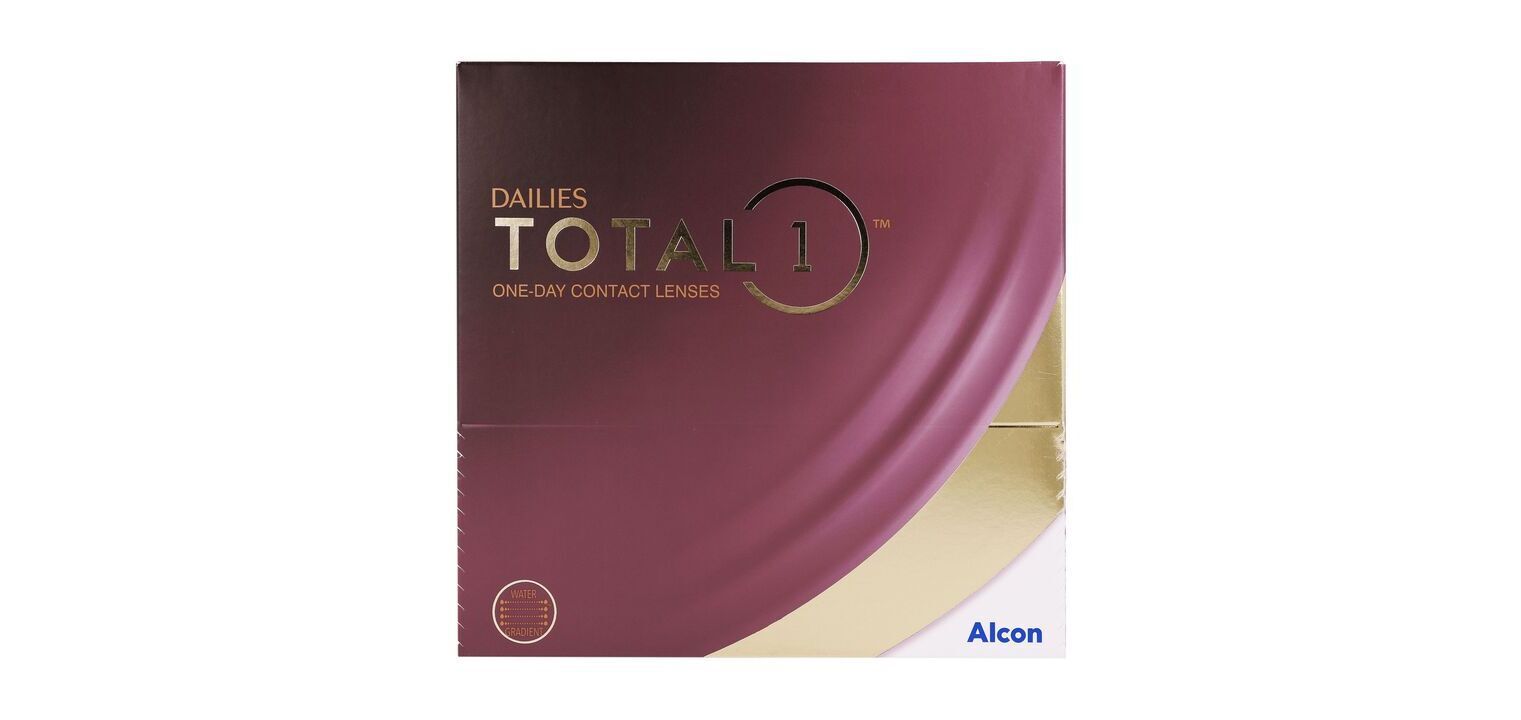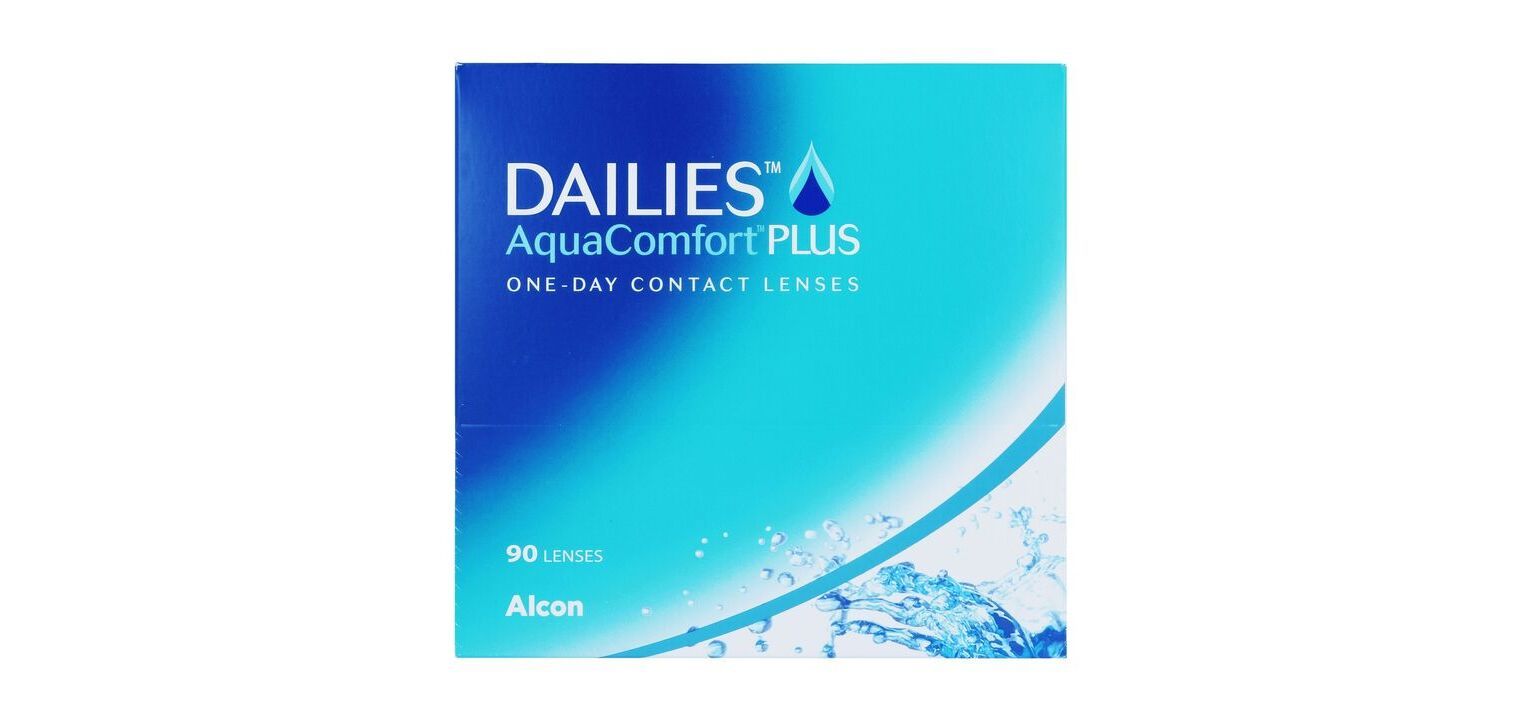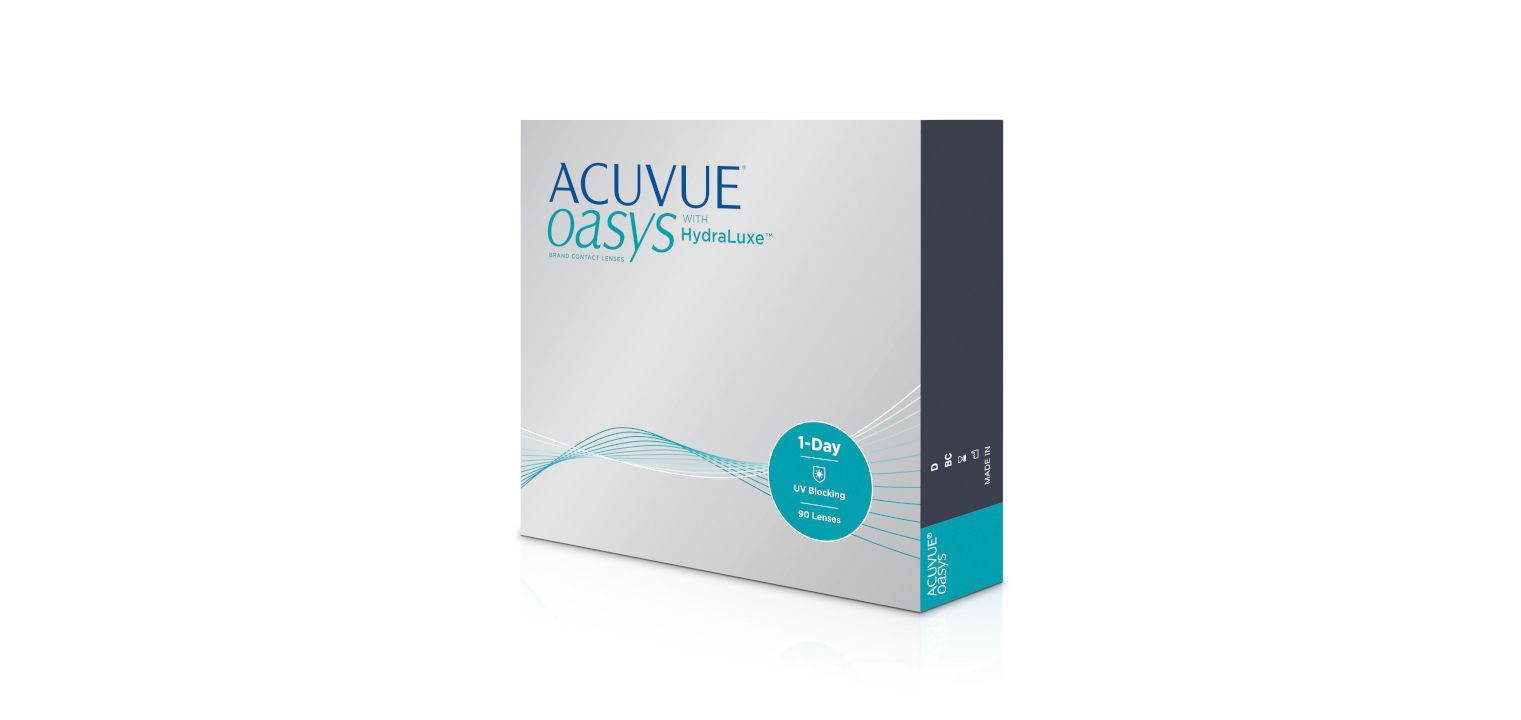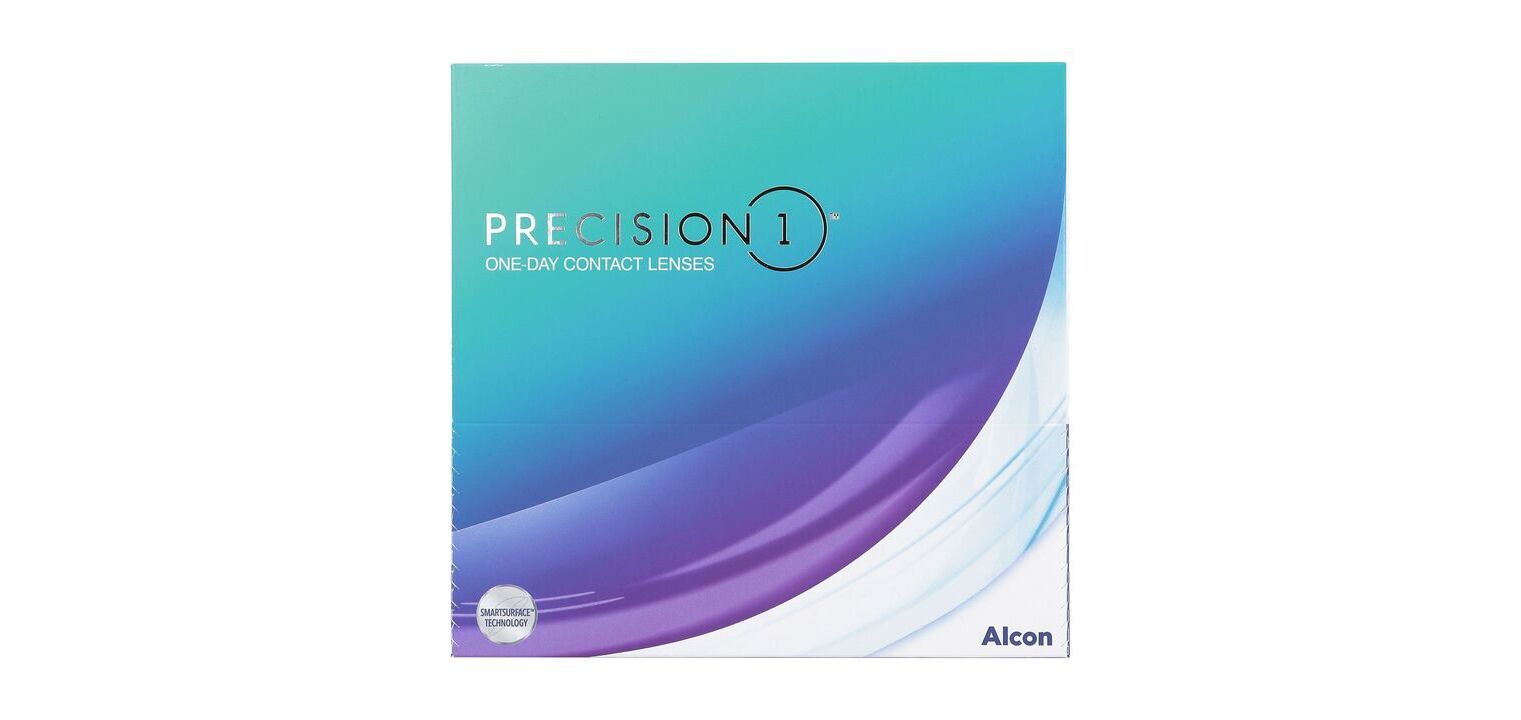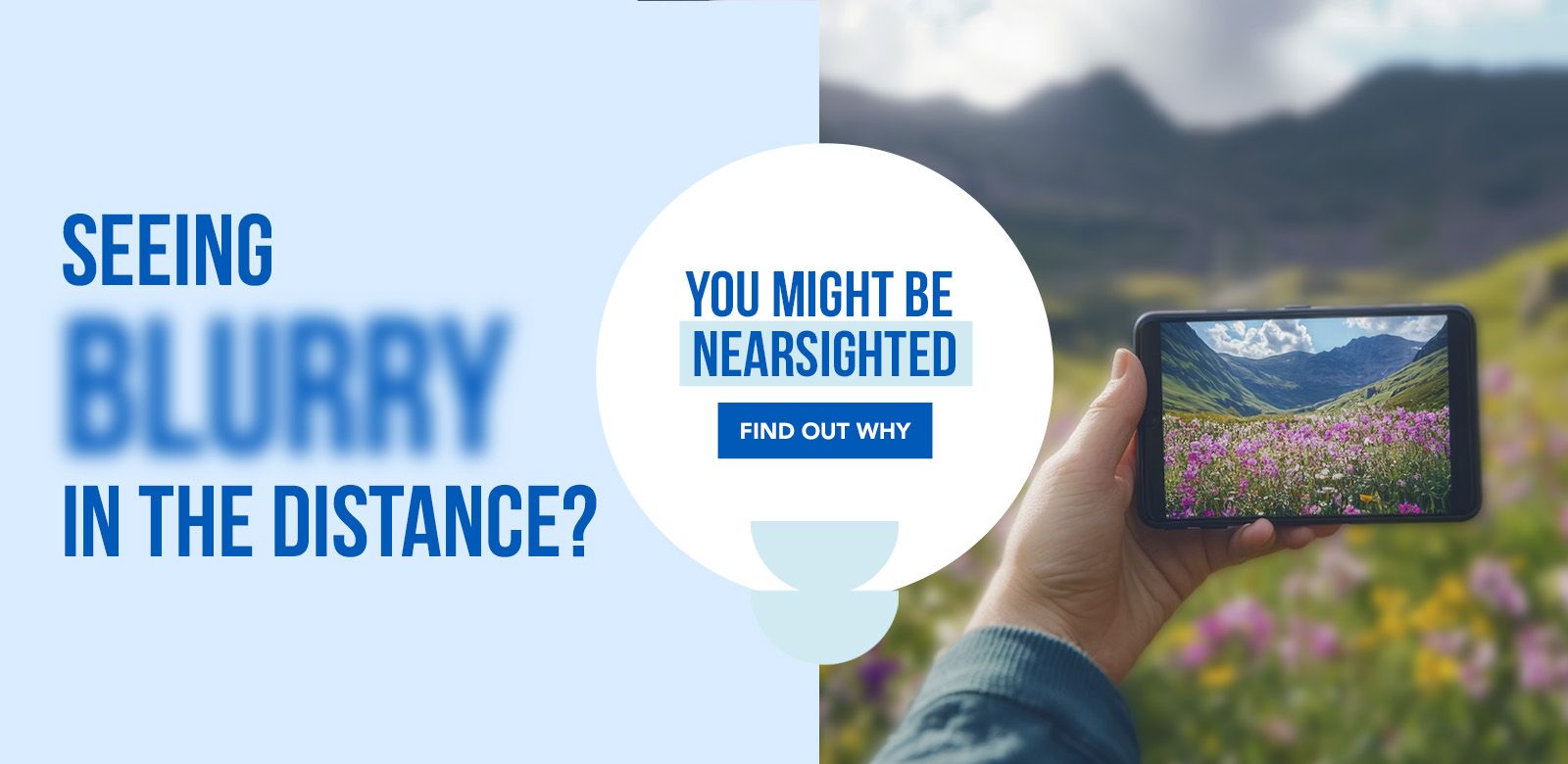

Having trouble reading road signs in the distance? Squinting to make out movie subtitles? These could be signs of myopia – a common condition that affects distance vision.
In this article, you’ll find out what myopia is, what causes it, and which solutions are available to help you see clearly again.
What is myopia?
Myopia means you see well up close, but objects in the distance appear blurry. This happens because the image forms slightly too early in your eye, just before it reaches the retina. It’s usually caused by an eyeball that’s too long or a cornea that’s too curved – as pictured in the diagram below.
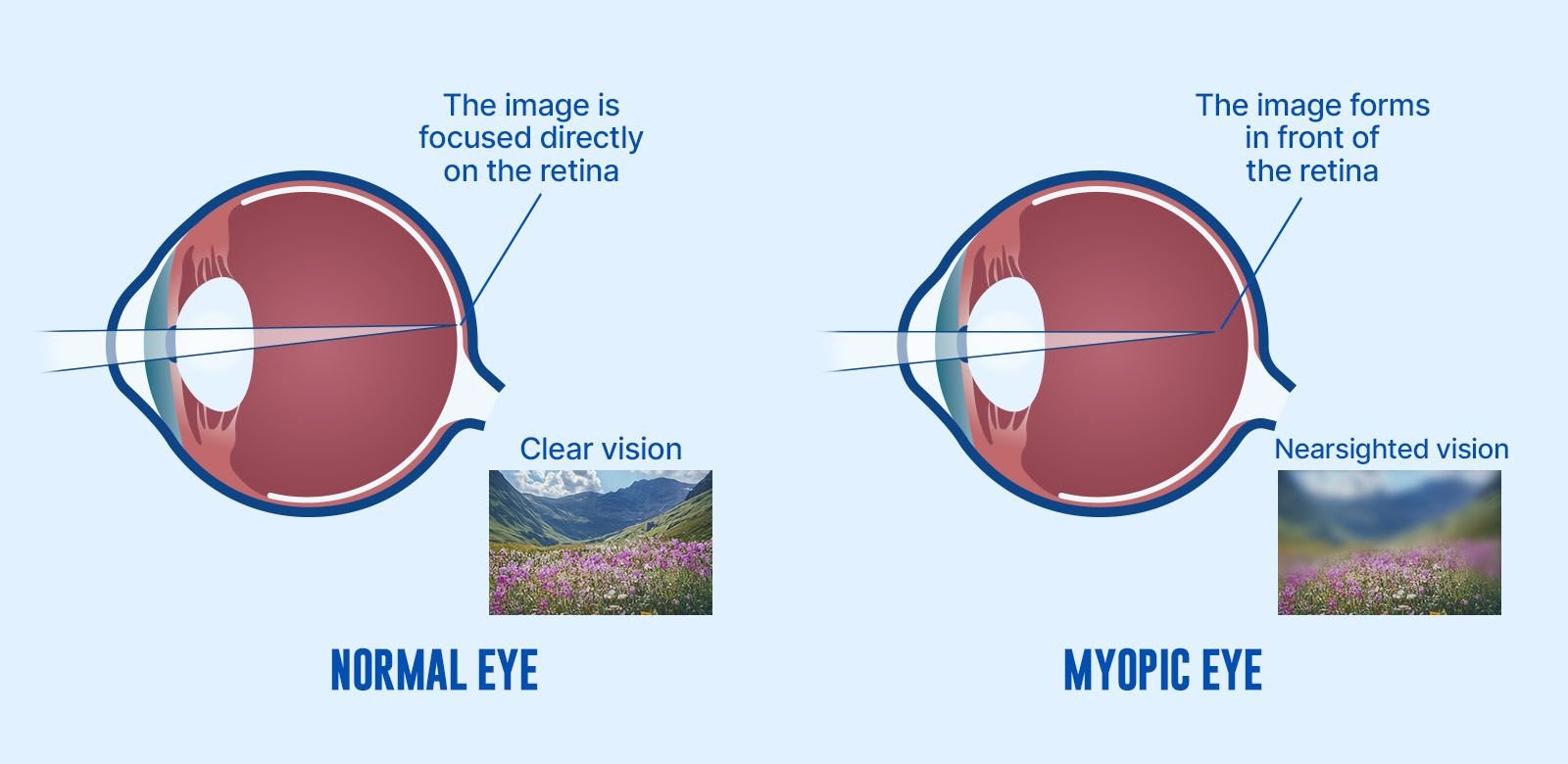

Myopia in numbers
Today, myopia affects more than just a small portion of the population. Once a minor condition, it’s now increasingly common – especially among children and teens.
According to the the journal Ophthalmolgy, nearly 50% of the global population¹ could be affected by 2050.
This rise is largely linked to lifestyle changes, such as spending more time indoors and using screens intensively. The World Health Organisation report also highlights an alarming trend in East Asia, where more than 80% of young adults are already affected by myopia.²
What factors increase the risk of myopia?
1. Genetic predisposition
If one parent is myopic, the risk doubles. If both are, this can increase your chances up to eightfold.³
2. Extended near-vision activities
Spending hours reading, writing or using screens without regular breaks strains your eye muscles. Over time, this can cause the eye to elongate and lead to blurred distance vision.
3. Excessive screen
Studies show that each additional hour of daily screen time (watching videos, doing homework, or scrolling on social media) increases the risk of myopia by 21% in children and teens.⁴
What are the first signs of myopia?
-
Blurry vision at a distance – you struggle to read subtitles or road signs.
-
Squinting – you often squint to see distant objects more clearly.
-
Eye strain – by the end of the day, your eyes feel tired, itchy or you get headaches after using your distance vision.
-
Holding things too close – you tend to bring your phone or book closer than usual to see properly.
Important: If you notice any of these symptoms, it’s highly recommended to book an eye exam with a vision specialist.
How to slow down myopia
Even if you can’t control hereditary factors, building better habits can help slow down the onset or progression of myopia.
-
Take regular breaks during near-vision tasks: Follow the 20-20-20 rule when reading, working on a screen or using your phone. Every 20 minutes, look at something about 20 feet (6 meters) away for at least 20 seconds.
-
Keep a healthy distance: Avoid holding books or screens too close to your face. Keep around 30–40 cm between your eyes and a book, and at least 50–70 cm for a computer screen.
Simple habits like these can make a noticeable difference to your eye health.
What are the options to correct myopia?
There are many effective solutions today to correct mild to severe myopia, depending on your lifestyle, budget and visual needs.
Glasses
Glasses are the most common and straightforward solution. However, they can be inconvenient during sports and often come with a higher cost.
Orthokeratology (Ortho-K)
This method involves wearing special rigid lenses overnight to reshape the cornea. No need for lenses during the day, but this option requires strict hygiene and isn’t suitable for every prescription.
Surgery
Laser surgery offers a long-term correction, but comes with a higher cost and some risks, like any surgical procedure.
Contact lenses
Among the most popular options, spherical lenses provide precise correction by adapting to the surface of your eye.
Whether you go for daily, bi-weekly or monthly use, there’s a lens to suit every routine.
They offer a great balance between clear vision, comfort and affordability.
Which lenses should you choose to correct myopia?
To help you make the right decision, here’s a comparison chart summarizing the main types of lenses, their benefits and price ranges.
| Lenses type |
Replacement frequency |
Main benefits |
Products |
Price |
Monthly price |
|
Daily lenses |
Every day (single-use) |
|
(Pack of 90) |
CHF 52.80 |
CHF 17.60 |
|
Bi-weekly lenses |
Every 2 weeks |
|
Acuvue Oasys with Hydraclear Plus (Pack of 6) |
CHF 44.00 |
CHF 8.80 |
|
Monthly lenses |
One a month |
|
(Pack of 6) |
CHF 36.10 |
CHF 6.01 |
The chart above gives you a quick overview of the different types of lenses available on the market.
-
Daily lenses are perfect if you're looking for maximum comfort with zero maintenance. They can be thrown away at the end of the day – no cleaning needed. They’re ideal if you have sensitive eyes, wear lenses occasionally, or just want an ultra-hygienic option.
-
Bi-weekly lenses need basic but regular care. Just rinse them every evening with a multi-purpose solution, like the one from AoSept. This type is a favourite among those looking for a great price-to-comfort ratio.
-
Monthly lenses require a more consistent cleaning routine: daily cleaning and rinsing, and sticking to the replacement schedule. That said, they’re the most economical choice in the long run – especially if you wear lenses every day. For the best hygiene and care, solutions from Opti-Free or Biotrue are a great match
Our tips: With the AboMax lens subscription, you’ll never forget to reorder. You receive your lenses and solution automatically, at the delivery frequency of your choice – and get 15% off for life.
Discover our range of spherical lenses
Myopia affects millions of people today – but the good news is it’s easily corrected with spherical lenses. They’re the perfect balance between sharp vision, all-day comfort and great value.
At Linsenmax, you’ll find top brands like Dailies, Acuvue, Biofinity and more – always at the best price. Thanks to our fast shipping across Switzerland, your lenses arrive straight to your
door, hassle-free.
Ready to choose comfort and freedom? Consult a specialist to find your ideal lenses!
FAQ – Frequently asked questions about myopia
Yes, myopia doesn't only affect kids and teens. The following situations may cause myopia to develop or worsen in adulthood:
-
Late-onset myopia – some people develop progressive myopia during their late teens or even after age 25.
-
Screen-related eye fatigue – extended screen time can lead to elongation of the eyeball, a common cause of myopia.
-
Hormonal changes or pregnancy – for some women, these factors may cause vision to shift temporarily.
-
Pathological myopia – in rare cases, myopia can develop as a symptom of another eye condition.
Myopia causes blurry distance vision.
Astigmatism distorts vision at all distances, due to an irregular shape of the cornea or lens.
Absolutely. Today, there are spherical contact lenses designed to correct high levels of myopia while still offering excellent daily comfort.
Here’s a selection of lenses suited for higher prescriptions:
- Dailies Total1 – made from delefilcon A, available up to -12.00 diopters. Exceptional moisture retention for lasting comfort.
- Precision1 – daily lenses with class 1 UV protection and stable vision, also effective up to -12.00 diopters.
- Biofinity – monthly silicone hydrogel lenses designed for extended wear, offering excellent hydration and performance for high corrections.
- Biomedics 55 Evolution – monthly lenses with class 2 UV protection, designed for comfort and visual clarity at strong corrections.
Important: Always consult an eye care professional before choosing your lenses. They’re the only ones who can recommend the right model based on your prescription and lifestyle.
That depends on the type of lens and your eye sensitivity.
Daily lenses are generally safe to wear for up to 12 hours, but always follow your optician’s recommendations.
Sources
¹ Brien A. Holden & al. « Global Prevalence of Myopia and High Myopia and Temporal Trends from 2000 through 2050 » - https://www.aaojournal.org/article/S0161-6420(16)00025-7/fulltext
² Organisation mondiale de la santé (OMS) - Rapport sur la santé visuelle mondiale - Données issues de synthèses journalistiques et de publications scientifiques, faisant état de projections alarmantes concernant la prévalence de la myopie d’ici 2050. https://www.who.int/fr/publications/i/item/9789241516570 Brien A. Holden & al. « Global Prevalence of Myopia and High Myopia and Temporal Trends from 2000 through 2050 ». Ophtalmology. 11/02/16
³ Ensemble contre la myopie - Les facteurs de risque de la myopie - https://ensemblecontrelamyopie.fr/les-facteurs-de-risque/
⁴ Acuité.fr - Temps d’écran et myopie : une étude confirme le risque accru dès la première heure - https://www.acuite.fr/actualite/sante/302644/temps-decran-et-myopie-une-etude-confirme-le-risque-accru-des-la-premiere






